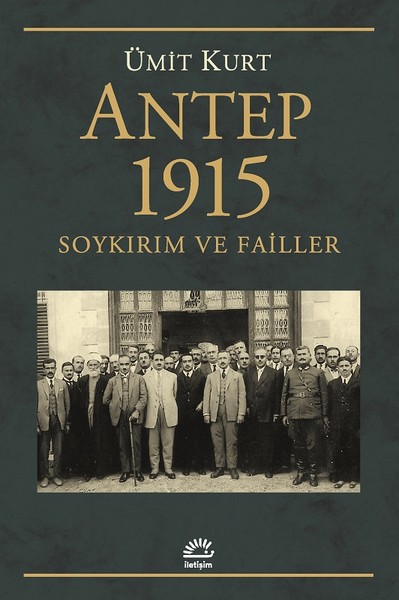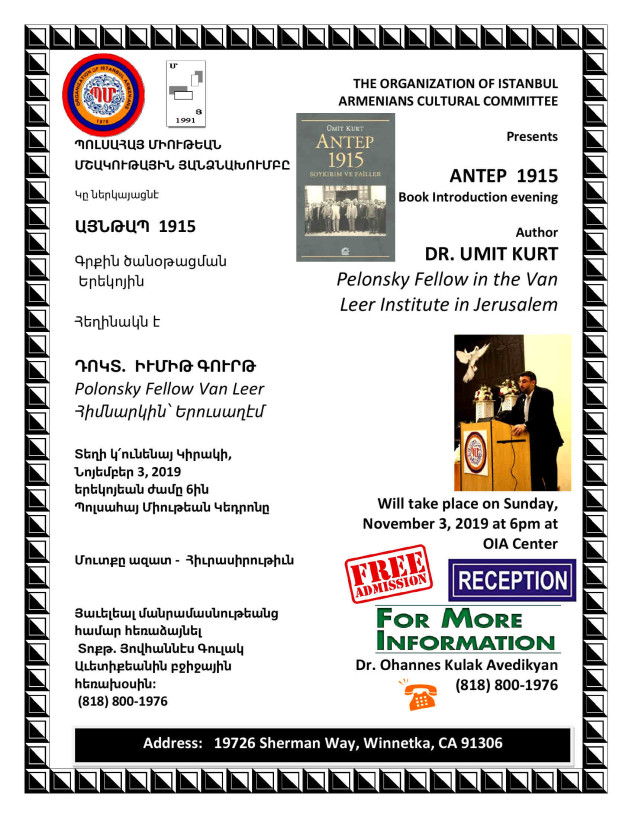
Հայկական, օսմանեան-թրքական, բրիտանական և ֆրանսական արխիւներուն մէջ առաջնային աղբիւրներէն նկարելը, յուշագրութիւնները, անձնական թերթերը, ցուցմունքներու վկայագրերը և յանցագործներու սերունդներու հետ հարցազրոյցները, Այնթապ 1915. «The Perpetrators» գիրքը կը կեդրոնանայ երեք սովորական յանցագործներու կեանքին վրայ, որոնք կը մեղադրուին ուղղակիօրէն մասնակցելով, չնայած տարբեր աստիճանի, հայերու տեղահանութեան և բնաջնջման և անոնց ունեցուածքի թալանմանը 1915-1917 թուականներուն Օսմանեան շրջանի Այնթապի մէջ, այնուհետև Հալէպի նահանգի մէջ: Այնթապն այսօր յայտնի է որպէս Կազիայնթապ, որ կը գտնուի Եփրատի արևմուտքէն 55 քմ դէպի արևմուտք և ժամանակակից թուրք-սուրիական սահմանէն 45 քմ դէպի հիւսիս: Այդ երեք տղամարդիկն էին Ալի Ճենանին (1872-1934), Ահմետ Ֆայիկ Էրները (1879-1967) և Մեհմեթ Եասին Սանի Քութլուղը (1889-1973): Հիմնուելով զանազան աղբիւրներու, դէպքերու իրադարձութիւններու եւ դրդապատճառներու վրայ, որ վերափոխեց այս երեք կերպարները Ցեղասպանութեան գործօն մասնակիցներու, որոնք կը մտնեն այս գիրքին զննումի տեսադաշտին մէջ:1915 թ.-ին Այնթապը Ցեղասպանութեան ոճրագործութեան հիմնախնդիրներու խթանիչն էր, որպէս մարդկութեան պայման և փորձ, Ալի Ճենանին ՝ որպէս պատեհապաշտ դաւանակից ոճրագործ կեանքի պատմութիւններու շուրջ, որ դիրքաւորուած է ՝ ելլելով իրավիճակէն, անձէն և ենթադրութենէն: Ահմեդ Ֆայկ Էրների ՝ որպէս հիմնական յանցագործ, որ միացուած է միութենական գաղափարախօսութեանը և մտածելակերպին և Մեհմեթ Եասին Սանի Քութլուղի ՝ որպէս սրարշաւի ոճրագործ, որ ցանկացած էր պետութեան վերին աստիճանաշարին, ցանկանալով բարձրանալ պարզ ռազմական առաքելութենէն մինչև տեղակալ և մինչև Անկախութեան Դատարանին անդամակցիլը:Drawing from primary sources in Armenian, Ottoman-Turkish, British, and French archives, memoirs, personal papers, testimonial accounts, and interviews with the descendants of perpetrators, Antep 1915: The Perpetrators book centers on the lives of three ordinary perpetrators accused of directly participating – although at varying degrees – in the deportation and extermination of the Armenians and pillage of their property from 1915 to 1917 in the Ottoman district of Aintab, then in the province of Aleppo province. Aintab is known today as Gaziantep, located 55 kilometers to the west of the Euphrates and 45 kilometers to the north of the modern Turkish-Syrian border. These men were Ali Cenani (1872-1934), Ahmed Faik Erner (1879-1967), and Mehmet Yasin Sani Kutluğ (1889-1973). Based on various sources, the courses of events and motivations that transformed these three characters into active participants of genocide enter the purview of this book.Antep 1915 is in the pretense of the problematization of genocide’s perpetration as the condition and experiment of humanity, over the life stories of Ali Cenani as an opportunist-conformist perpetrator who positioned himself based on the situation, person, and conjecture; of Ahmed Faik Erner as a perpetrator connected from the core to the Unionist ideology and mindset; and of Mehmet Yasin Sani Kutluğ as a careerist perpetrator who yearned for the upper echelons of the state with a desire to rise up from a simple military shipping officer to a deputy and up to membership on the Independence Tribunal. |
…

